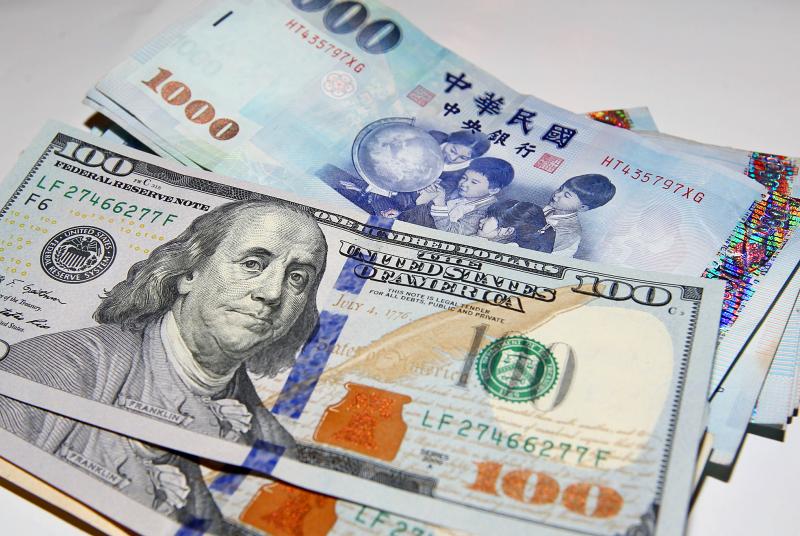Taiwan’s foreign exchange reserves last month picked up US$3.8 billion to US$548.5 billion, ending two months of decline, thanks to seasonal dividend income from bond holdings and value gains in non-US dollar reserve currencies, the central bank said yesterday.
The latest balance indicated that Taiwan retained its status as the world’s fourth-largest foreign reserve holder after China, Japan and Switzerland, after overtaking India in April.
“The central bank’s holdings in US government bonds received a boost from seasonal dividend incomes and value advances in major reserve currencies other than the greenback,” Department of Foreign Exchange Director-General Eugene Tsai (蔡炯民) told a news conference in Taipei.

Photo: CNA
The euro last month rose 2.27 percent against its US counterpart, while the British pound increased 1.07 percent and the Japanese yen grew 1.99 percent, Tsai said.
The central bank intervened in the local foreign exchange market to maintain stability in the local currency and achieved a neutral effect due to the moderate amount involved, he said.
The local foreign exchange market was volatile last month, with many wondering how far the US dollar’s appreciation would go, Tsai said, adding that the greenback weakened in the second half of the month after economic uncertainty loomed, raising hope that the US Federal Reserve would ease monetary tightening.
Such expectations lent support to emerging market currencies including the New Taiwan dollar, he said.
That explains why foreign stock players modestly increased holdings in local shares, but pressed ahead with net capital flight of US$1 billion to pursue higher yields elsewhere, he added.

CHIP RACE: Three years of overbroad export controls drove foreign competitors to pursue their own AI chips, and ‘cost US taxpayers billions of dollars,’ Nvidia said China has figured out the US strategy for allowing it to buy Nvidia Corp’s H200s and is rejecting the artificial intelligence (AI) chip in favor of domestically developed semiconductors, White House AI adviser David Sacks said, citing news reports. US President Donald Trump on Monday said that he would allow shipments of Nvidia’s H200 chips to China, part of an administration effort backed by Sacks to challenge Chinese tech champions such as Huawei Technologies Co (華為) by bringing US competition to their home market. On Friday, Sacks signaled that he was uncertain about whether that approach would work. “They’re rejecting our chips,” Sacks

NATIONAL SECURITY: Intel’s testing of ACM tools despite US government control ‘highlights egregious gaps in US technology protection policies,’ a former official said Chipmaker Intel Corp has tested chipmaking tools this year from a toolmaker with deep roots in China and two overseas units that were targeted by US sanctions, according to two sources with direct knowledge of the matter. Intel, which fended off calls for its CEO’s resignation from US President Donald Trump in August over his alleged ties to China, got the tools from ACM Research Inc, a Fremont, California-based producer of chipmaking equipment. Two of ACM’s units, based in Shanghai and South Korea, were among a number of firms barred last year from receiving US technology over claims they have

It is challenging to build infrastructure in much of Europe. Constrained budgets and polarized politics tend to undermine long-term projects, forcing officials to react to emergencies rather than plan for the future. Not in Austria. Today, the country is to officially open its Koralmbahn tunnel, the 5.9 billion euro (US$6.9 billion) centerpiece of a groundbreaking new railway that will eventually run from Poland’s Baltic coast to the Adriatic Sea, transforming travel within Austria and positioning the Alpine nation at the forefront of logistics in Europe. “It is Austria’s biggest socio-economic experiment in over a century,” said Eric Kirschner, an economist at Graz-based Joanneum

BUBBLE? Only a handful of companies are seeing rapid revenue growth and higher valuations, and it is not enough to call the AI trend a transformation, an analyst said Artificial intelligence (AI) is entering a more challenging phase next year as companies move beyond experimentation and begin demanding clear financial returns from a technology that has delivered big gains to only a small group of early adopters, PricewaterhouseCoopers (PwC) Taiwan said yesterday. Most organizations have been able to justify AI investments through cost recovery or modest efficiency gains, but few have achieved meaningful revenue growth or long-term competitive advantage, the consultancy said in its 2026 AI Business Predictions report. This growing performance gap is forcing executives to reconsider how AI is deployed across their organizations, it said. “Many companies